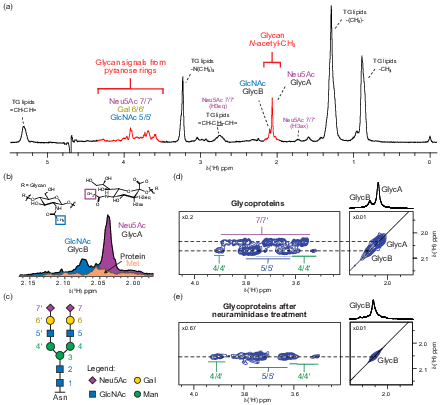NMR and Metabolomics
Research Topics
- NMR methods for metabolomics and metabolic fluxes by NMR
- Metabolic fluxes in cancer cells
- NMR metabolomics screening
- new glycoprotein methods
- identification of new biomarkers for different clinical cohorts (cancer, IBD, NASH, Parkinson's disease, etc)
- Development of new computational tools for NMR proteo-metabolomics
- spectra processing using Matlab
- lineshape fitting for quantification
- statistical analysis
- Deciphering the NMR signatures of different sample materials
- blood: serum and plasma
- urine
- stool
Quantification of glycosylated acute-phase proteins in blood via NMR-spectroscopy
Nuclear Magnetic Resonance (NMR) is a well-established method for metabolomics of blood samples. The NMR spectrum of blood shows signals of small molecule metabolites, lipoproteins, and two distinct signals arising from acetyl groups of protein-bound glycans. The latter are known as GlycA and GlycB and have previously been proposed as diagnostic markers for cardiovascular diseases. Arising from glycans decorating a series of well-known and highly abundant acute-phase proteins, these markers bear significant diagnostic potential. Recent work showing a strong response of GlycA/B signals in COVID-19 demonstrates the importance of such glycosylation markers in response to inflammatory conditions. These findings prompted us to further study the origin of these signals in much greater detail to evaluate their true diagnostic potential. In a recent publication in Angewandte Chemie, we showed how these signals can be decomposed to derive quantitative information about the glycosylation type and the nature of the glycosylated proteins [1]. Overall, this opens new avenues for the use of glycosylation biomarkers, especially as the NMR analysis proposed here is fast, inexpensive, and can be carried out using native blood serum or plasma samples.
Prof. Dr. Ulrich Günther
Co-workers
Dr. Alvaro Mallagaray
Dr. Ashok Kumar Rout
Lorena Rudolph, M.Sc.
Melissa Lindloge, B.Sc.





